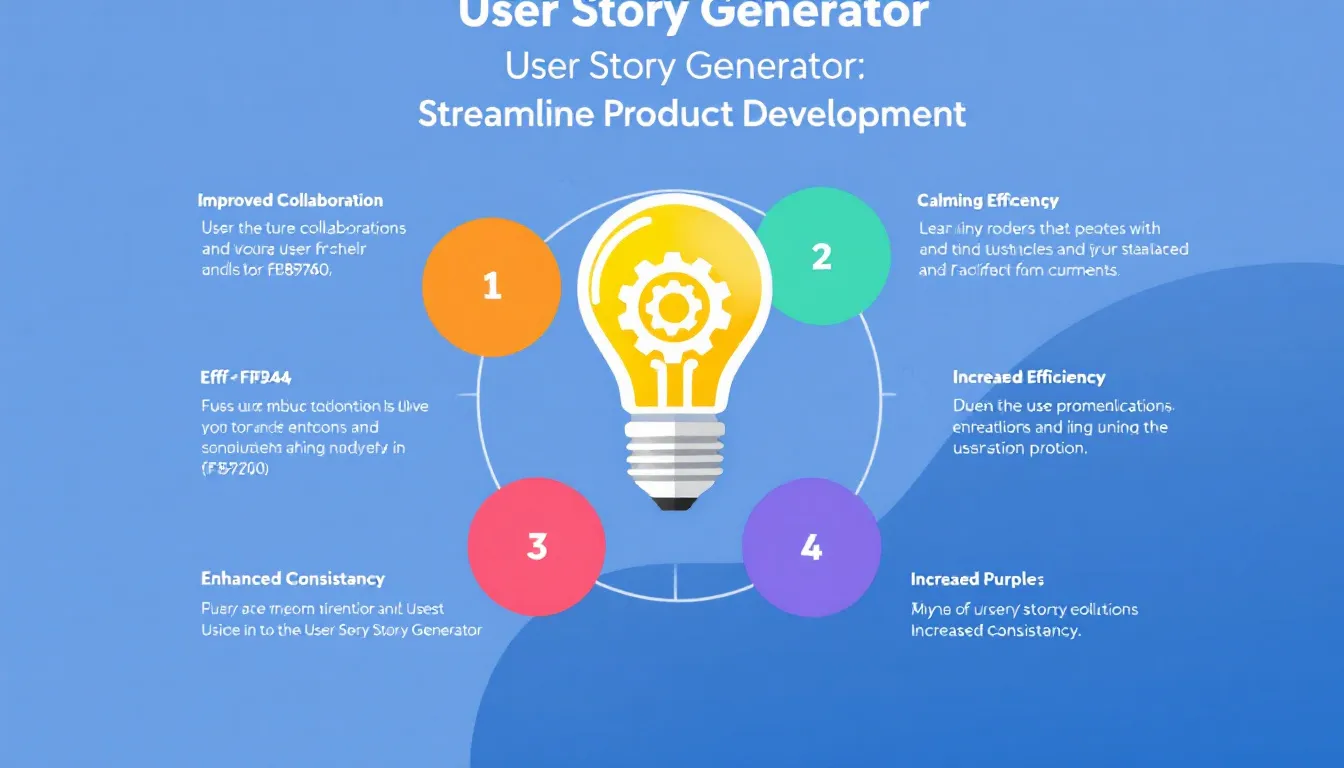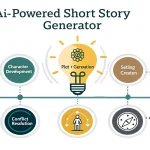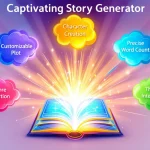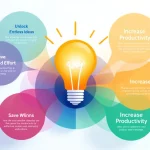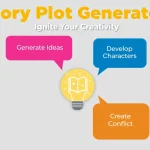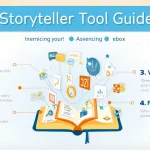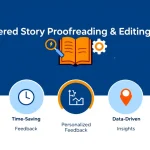Is this tool helpful?
How to Use the User Story Generator Tool Effectively
To make the most of our User Story Generator Tool, follow these simple steps:
- Enter the Product Name: In the first field, input the name of the product for which you’re creating user stories. For example, you might enter “SmartHome Assistant” or “HealthTrack Fitness App”.
- Provide a Detailed Product Description: In the text area, describe your product comprehensively, including its features and purpose. For instance, “A voice-activated home automation system that controls lighting, temperature, and security devices, with AI-powered learning capabilities to adapt to user preferences over time.”
- List User Types: Specify the different types of users who will interact with your product. This could be “Homeowners, Elderly residents, Tech-savvy millennials” or “Fitness enthusiasts, Personal trainers, Nutrition coaches”.
- Define Strategic Goals (Optional): If you have specific strategic objectives for your product, enter them in this field. For example, “Increase smart home adoption among first-time buyers, Reduce energy consumption in households, Enhance home security features”.
- Generate User Stories: Click the “Generate User Stories” button to process your input and create comprehensive user stories.
- Review and Copy Results: Once generated, review the user stories in the results section. Use the “Copy to Clipboard” button to easily transfer the content for further use in your product development process.
By providing accurate and detailed information in each field, you’ll ensure that the generated user stories are tailored to your specific product and user base, maximizing their value in guiding your development efforts.
Understanding User Stories: A Powerful Tool for Product Development
User stories are a fundamental component of agile software development and product management. They serve as concise, user-centric descriptions of product features or functionalities, framed from the perspective of the end-user. Our User Story Generator Tool is designed to streamline the process of creating these essential narratives, helping product managers, developers, and stakeholders align their efforts with user needs and expectations.
The Anatomy of a User Story
A well-crafted user story typically follows this structure:
“As a [type of user], I want [an action] so that [benefit].”
This format encapsulates three crucial elements:
- The user: Who is the story about?
- The action: What does the user want to accomplish?
- The benefit: Why does the user want to accomplish this?
By focusing on these elements, user stories help teams maintain a user-centric approach throughout the development process, ensuring that every feature or functionality serves a clear purpose and delivers tangible value to the end-user.
The Purpose and Benefits of User Stories
User stories serve multiple purposes in the product development lifecycle:
- User-Centric Focus: They keep the end-user at the forefront of development decisions.
- Clear Communication: They provide a common language for stakeholders, developers, and users to discuss product features.
- Prioritization: They help in prioritizing features based on user value and strategic goals.
- Flexibility: They allow for iterative development and easy adjustments as user needs evolve.
- Testability: They provide a basis for creating acceptance criteria and test cases.
By leveraging these benefits, teams can create products that truly resonate with their target audience and deliver exceptional user experiences.
Benefits of Using the User Story Generator Tool
Our User Story Generator Tool offers numerous advantages for product managers, developers, and stakeholders involved in the product development process:
1. Time and Resource Efficiency
Crafting well-structured user stories can be time-consuming, especially for complex products with diverse user bases. Our tool significantly reduces the time and effort required to generate comprehensive user stories, allowing teams to focus more on analysis and implementation rather than story creation.
2. Consistency and Quality
The tool ensures that all generated user stories follow a consistent format and structure. This consistency enhances readability and comprehension across the team, reducing misunderstandings and ensuring that all stories meet a high-quality standard.
3. Comprehensive Coverage
By prompting users to consider various aspects of their product and user base, the tool helps ensure comprehensive coverage of potential user stories. This reduces the likelihood of overlooking important features or use cases during the planning phase.
4. Strategic Alignment
The inclusion of strategic goals in the input process helps align generated user stories with overarching product objectives. This ensures that each story not only addresses user needs but also contributes to the product’s strategic direction.
5. Enhanced Collaboration
The tool provides a common starting point for discussions about user needs and product features. Generated stories can serve as a catalyst for team brainstorming sessions, fostering collaboration and encouraging diverse perspectives on user requirements.
6. Scalability
Whether you’re working on a small project or a large-scale product, the User Story Generator Tool can scale to meet your needs. It can quickly produce a large number of user stories for complex products, saving significant time in the initial planning stages.
7. Improved User Empathy
By systematically considering different user types and their needs, the tool helps development teams cultivate a deeper sense of empathy for their end-users. This user-centric mindset can lead to more thoughtful and effective product design decisions.
Addressing User Needs and Solving Problems
The User Story Generator Tool is designed to address several key challenges faced by product development teams:
1. Bridging the Gap Between User Needs and Technical Requirements
One of the primary challenges in product development is translating user needs into actionable technical requirements. The User Story Generator Tool bridges this gap by creating clear, user-focused narratives that developers can easily understand and implement. For example:
“As a busy professional, I want to set recurring tasks with customizable reminders so that I can manage my regular responsibilities without constantly recreating to-do items.”
This user story clearly communicates the user’s need (managing recurring tasks) and the desired functionality (customizable reminders), providing a solid foundation for developers to design and implement the feature.
2. Ensuring Comprehensive Feature Coverage
Products often have multiple user types with diverse needs. The tool helps ensure comprehensive coverage by prompting the input of various user types and generating stories for each. For instance, consider a project management application:
- “As a project manager, I want to assign tasks to team members with due dates so that I can track project progress and ensure timely completion.”
- “As a team member, I want to view my assigned tasks in a calendar format so that I can plan my workload effectively.”
- “As a client, I want to view real-time project status updates so that I can stay informed without scheduling frequent meetings.”
These stories cover the needs of different user types, ensuring that the product caters to all stakeholders.
3. Prioritizing Features Based on User Value
The tool helps teams prioritize features by generating user stories that clearly articulate the benefit to the user. This allows product managers to assess the potential impact of each feature and prioritize development accordingly. For example:
“As a social media manager, I want to schedule posts across multiple platforms simultaneously so that I can save time and ensure consistent messaging across channels.”
The clear benefit (time-saving and consistency) helps in evaluating the feature’s importance relative to others.
4. Facilitating Iterative Development
Agile development requires flexibility and the ability to adapt to changing requirements. The User Story Generator Tool supports this by allowing quick generation of new stories as product understanding evolves. For instance, if user feedback reveals a new need:
“As a mobile user, I want to access all features offline so that I can use the app without an internet connection during my commute.”
This new story can be quickly generated and integrated into the development backlog, ensuring the product remains responsive to user needs.
Practical Applications and Use Cases
The User Story Generator Tool can be applied across various industries and product types. Here are some practical examples:
1. E-commerce Platform
For an e-commerce platform, the tool might generate stories like:
- “As a shopper, I want to filter products by multiple attributes so that I can quickly find items that meet my specific criteria.”
- “As a seller, I want to offer bundle discounts on related products so that I can increase my average order value.”
- “As a repeat customer, I want to save my payment and shipping information so that I can complete purchases more quickly in the future.”
2. Healthcare Management System
For a healthcare management system, user stories might include:
- “As a patient, I want to book appointments online so that I can schedule medical visits at my convenience without phone calls.”
- “As a doctor, I want to access patient history and test results in one interface so that I can make informed decisions quickly during consultations.”
- “As an administrator, I want to generate reports on patient demographics and common diagnoses so that I can optimize resource allocation and inventory management.”
3. Educational Technology Platform
For an educational technology platform, the tool might produce stories such as:
- “As a student, I want to track my progress across different subjects so that I can identify areas needing improvement.”
- “As a teacher, I want to create customized quizzes with automatic grading so that I can assess student understanding efficiently.”
- “As a parent, I want to receive regular updates on my child’s performance so that I can provide timely support and encouragement.”
4. Fitness Tracking Application
For a fitness tracking app, user stories could include:
- “As a runner, I want to set personal goals and receive tailored training plans so that I can improve my performance systematically.”
- “As a gym-goer, I want to log my workouts and track my strength progress over time so that I can stay motivated and adjust my routine as needed.”
- “As a nutrition-conscious user, I want to integrate my meal plans with my workout schedule so that I can optimize my diet for my fitness goals.”
Frequently Asked Questions (FAQ)
Q1: How many user stories should I create for my product?
A1: The number of user stories depends on the complexity of your product and the diversity of your user base. Start with 10-15 core stories covering the main features and user types, then expand as needed during development iterations.
Q2: Can I edit the generated user stories?
A2: Absolutely! The generated stories serve as a starting point. Feel free to refine, combine, or expand them to better fit your specific product needs and user feedback.
Q3: How detailed should my product description be?
A3: Provide as much detail as possible about your product’s features, purpose, and target audience. The more comprehensive your description, the more accurate and relevant the generated user stories will be.
Q4: Can I use this tool for non-software products?
A4: While primarily designed for software products, the User Story Generator Tool can be adapted for other product types. The key is to focus on user actions and benefits, which apply to any user-centric product or service.
Q5: How do I prioritize the generated user stories?
A5: Prioritize based on factors like user value, strategic alignment, and development effort. Consider using techniques like MoSCoW (Must have, Should have, Could have, Won’t have) or the RICE framework (Reach, Impact, Confidence, Effort) to systematically prioritize your stories.
Q6: Can this tool replace user research?
A6: No, this tool complements but doesn’t replace user research. It’s most effective when used in conjunction with insights gathered from actual user interviews, surveys, and observations.
Q7: How often should I update my user stories?
A7: Review and update your user stories regularly, especially at the start of new development sprints or when receiving significant user feedback. This ensures your stories remain aligned with evolving user needs and product goals.
Q8: Can I integrate these user stories with project management tools?
A8: Yes, the generated user stories can be easily copied and pasted into various project management and agile development tools like Jira, Trello, or Azure DevOps.
Q9: How do I handle conflicting user needs in stories?
A9: When user needs conflict, prioritize based on your product strategy and target user segments. Consider creating separate features or customization options to address diverse needs when possible.
Q10: Should I include technical details in user stories?
A10: User stories should focus on user needs and benefits rather than technical implementation. Keep technical details separate in the form of acceptance criteria or technical specifications associated with each story.
By leveraging the User Story Generator Tool and following best practices in user story creation and management, you can significantly enhance your product development process, ensuring that your final product truly meets user needs and delivers value to your target audience.
Important Disclaimer
The calculations, results, and content provided by our tools are not guaranteed to be accurate, complete, or reliable. Users are responsible for verifying and interpreting the results. Our content and tools may contain errors, biases, or inconsistencies. We reserve the right to save inputs and outputs from our tools for the purposes of error debugging, bias identification, and performance improvement. External companies providing AI models used in our tools may also save and process data in accordance with their own policies. By using our tools, you consent to this data collection and processing. We reserve the right to limit the usage of our tools based on current usability factors. By using our tools, you acknowledge that you have read, understood, and agreed to this disclaimer. You accept the inherent risks and limitations associated with the use of our tools and services.
